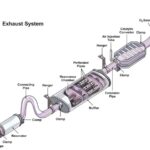Mahindra Obdii Scanning is crucial for diagnosing and maintaining your vehicle. Whether you own a Scorpio, Xylo, Bolero, XUV500, or Thar, understanding how to use an OBDII scanner can empower you to troubleshoot issues and ensure optimal performance. This guide explores the essential aspects of Mahindra OBDII scanning, including the necessary equipment, procedures, and interpretation of diagnostic trouble codes (DTCs).
Mahindra-Specific OBDII Cables and Connectors
Mahindra vehicles often require a specific OBDII cable with a DB-9 connector to interface with diagnostic tools. These cables connect the vehicle’s OBDII port, typically located near the steering wheel, to a compatible OBDII scanner or diagnostic software. A common cable used is the Python Mahindra OBD Male to DB-9 Male Diagnostic Cable. This specialized cable ensures proper communication between the vehicle’s electronic control unit (ECU) and the diagnostic equipment. This connection enables access to crucial vehicle data, including real-time sensor readings, error codes, and system information. A standard OBD2 extension cable with a 16-pin connector may not work directly with some Mahindra models.
Performing a Mahindra OBDII Scan
Connecting the OBDII scanner to your Mahindra vehicle is the first step in the scanning process. After establishing a secure connection with the appropriate cable, turn the ignition to the “ON” position without starting the engine. This activates the vehicle’s onboard diagnostics system, making it accessible to the scanner. Most OBDII scanners will automatically detect the vehicle and initiate communication.
Example of a Mahindra OBDII to DB9 cable
Once communication is established, you can begin retrieving diagnostic information. This typically involves reading DTCs, which are codes that indicate specific malfunctions detected by the vehicle’s ECU. The scanner will display these codes, along with their descriptions, allowing you to pinpoint the source of the problem. Beyond DTCs, Mahindra OBDII scanning provides access to live data streams from various sensors. This real-time information allows you to monitor engine parameters, transmission performance, emissions data, and other crucial system functions.
Understanding Mahindra OBDII Diagnostic Trouble Codes (DTCs)
Interpreting DTCs accurately is vital for effective troubleshooting. Each DTC corresponds to a specific fault within the vehicle’s systems. While generic OBDII codes apply to all vehicles, Mahindra may have manufacturer-specific codes that provide more detailed diagnostics. Consulting a Mahindra-specific DTC database or repair manual can help decipher these codes accurately.
Example of an OBDII scanner displaying diagnostic trouble codes
Utilizing OBDII Scan Data for Maintenance and Repair
Mahindra OBDII scanning is invaluable for both preventative maintenance and targeted repairs. Regularly scanning your vehicle allows you to identify potential problems before they escalate into major issues. By monitoring sensor data and addressing DTCs promptly, you can proactively maintain your Mahindra and prevent costly breakdowns. In addition to fault diagnosis, OBDII scanning can assist with various maintenance tasks. Some scanners offer functions such as resetting service reminders, performing component activations, and accessing system information required for specific repair procedures.
OBDII Connector Pinout Configuration
Understanding the pinout configuration of the OBDII connector is essential for troubleshooting connection issues or utilizing advanced diagnostic techniques. The following table provides a standard OBDII pinout configuration:
| Pin Number | Pin Name | Description |
|---|---|---|
| 2 | SAE J1850 Bus+ | Used by some GM vehicles. |
| 4,5 | Ground | Ground connection. |
| 6 | ISO15765-4 CAN High | High-speed CAN bus communication. |
| 7 | ISO 9141 – K Line | Used for communication in some vehicles. |
| 10 | SAE J1850 Bus- | Used by some GM vehicles. |
| 14 | ISO15765-4 CAN Low | Low-speed CAN bus communication. |
Diagram illustrating the standard OBDII connector pinout
Mahindra OBDII scanning is an essential tool for any owner seeking to maintain and repair their vehicle effectively. By understanding the process, interpreting DTCs, and utilizing the wealth of data available through OBDII, you can ensure your Mahindra remains in optimal condition for years to come.

